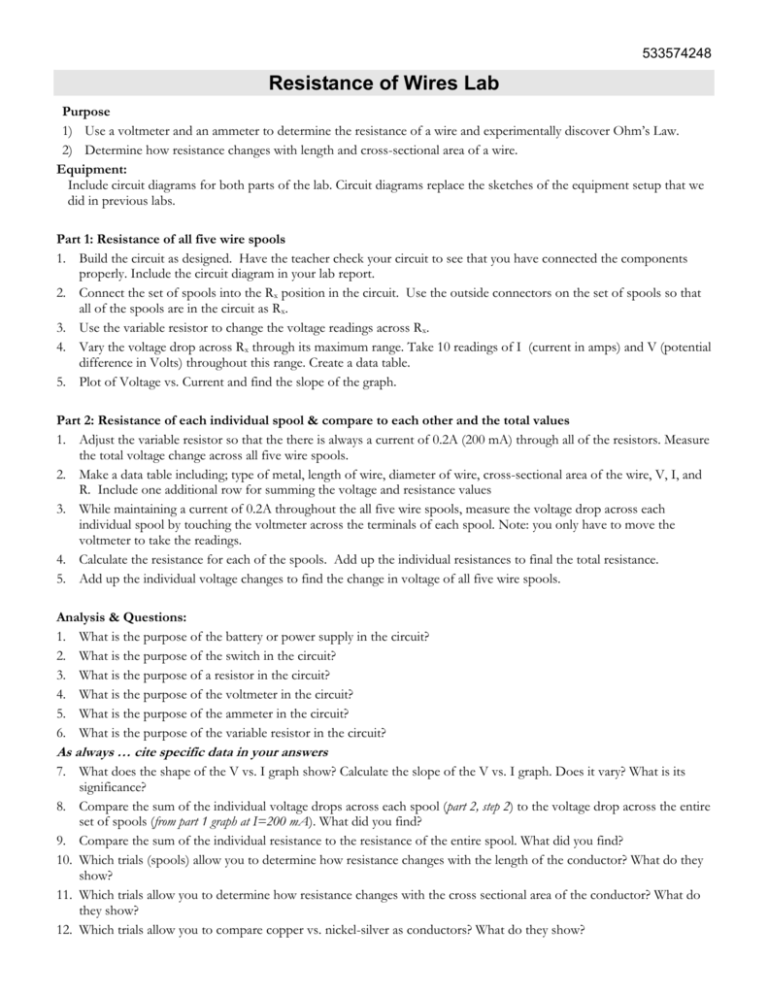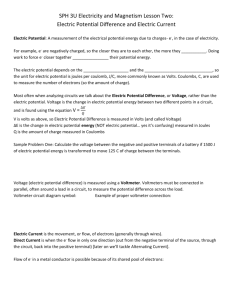Resistance
advertisement

533574248 Resistance of Wires Lab Purpose 1) Use a voltmeter and an ammeter to determine the resistance of a wire and experimentally discover Ohm’s Law. 2) Determine how resistance changes with length and cross-sectional area of a wire. Equipment: Include circuit diagrams for both parts of the lab. Circuit diagrams replace the sketches of the equipment setup that we did in previous labs. Part 1: Resistance of all five wire spools 1. Build the circuit as designed. Have the teacher check your circuit to see that you have connected the components properly. Include the circuit diagram in your lab report. 2. Connect the set of spools into the Rx position in the circuit. Use the outside connectors on the set of spools so that all of the spools are in the circuit as Rx. 3. Use the variable resistor to change the voltage readings across Rx. 4. Vary the voltage drop across Rx through its maximum range. Take 10 readings of I (current in amps) and V (potential difference in Volts) throughout this range. Create a data table. 5. Plot of Voltage vs. Current and find the slope of the graph. Part 2: Resistance of each individual spool & compare to each other and the total values 1. Adjust the variable resistor so that the there is always a current of 0.2A (200 mA) through all of the resistors. Measure the total voltage change across all five wire spools. 2. Make a data table including; type of metal, length of wire, diameter of wire, cross-sectional area of the wire, V, I, and R. Include one additional row for summing the voltage and resistance values 3. While maintaining a current of 0.2A throughout the all five wire spools, measure the voltage drop across each individual spool by touching the voltmeter across the terminals of each spool. Note: you only have to move the voltmeter to take the readings. 4. Calculate the resistance for each of the spools. Add up the individual resistances to final the total resistance. 5. Add up the individual voltage changes to find the change in voltage of all five wire spools. Analysis & Questions: 1. What is the purpose of the battery or power supply in the circuit? 2. What is the purpose of the switch in the circuit? 3. What is the purpose of a resistor in the circuit? 4. What is the purpose of the voltmeter in the circuit? 5. What is the purpose of the ammeter in the circuit? 6. What is the purpose of the variable resistor in the circuit? As always … cite specific data in your answers 7. What does the shape of the V vs. I graph show? Calculate the slope of the V vs. I graph. Does it vary? What is its significance? 8. Compare the sum of the individual voltage drops across each spool (part 2, step 2) to the voltage drop across the entire set of spools (from part 1 graph at I=200 mA). What did you find? 9. Compare the sum of the individual resistance to the resistance of the entire spool. What did you find? 10. Which trials (spools) allow you to determine how resistance changes with the length of the conductor? What do they show? 11. Which trials allow you to determine how resistance changes with the cross sectional area of the conductor? What do they show? 12. Which trials allow you to compare copper vs. nickel-silver as conductors? What do they show?








